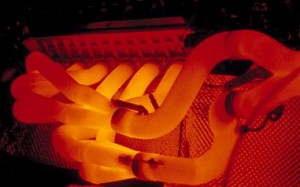

We are already aware that increasing temperature can convert a solid to liquid. It is interesting to note that the freezing point of a liquid is the same as the melting point of its solid state. This change of state from liquid to solid is called freezing and the temperature at which the liquid freezes is called its freezing point. On further lowering the temperature, the substance eventually freezes, that is, the liquid changes into a solid.

The kinetic energy of the particles decreases and the attractive forces pull the particles close together. On the other hand, lowering the temperature causes the reverse process. However, the absorbed heat gets hidden in the contents of the container. The temperature of the system, therefore, does not change even when the melting point is attained till all the ice melts into water. Heat energy (equal to the latent heat of fusion) absorbed during the change in state is used up in overpowering the strong attractive forces between the particles. The heat, therefore, gets hidden within the contents of the beaker and is called latent heat.ĭo you know that the particles in water have more energy as compared to particles in ice at a temperature of 0 degrees celsius? Let us find out why. As there is no increase in kinetic energy of the particles, the temperature of the system also does not show any rise during the change of state. This heat energy is actually used up in overcoming the forces of attraction between the particles of the solid during the change of state from solid to liquid.

You must be wondering where this energy goes? Isn’t it? It is also observed that even when the melting starts, the temperature of the system remains constant till the entire solid melts, even though heat is being continuously supplied. On heating some ice in a beaker at a low flame, you will observe that ice melts at a temperature of zero degrees Celsius or 273.16 Kelvin. Let us learn some more facts regarding the fusion of solids. The higher the strength of forces of attraction, the higher is the melting point. The melting point of a solid depends upon the strength of forces of attraction between the particles. The process of melting is also termed fusion. The amount of heat energy that is required to change one kilogram of a solid into liquid at atmospheric pressure is known as latent heat of fusion, and the temperature at which it occurs is known as its melting point.

And, the solid eventually melts into a liquid. The heat supplied overcomes the forces of attraction between the particles and the particles, therefore, start moving more freely. On increasing the temperature of solids, the kinetic energy of the particles increases which sets them into motion. But how does this change in the state of matter occurs? The temperature has an important role here. We know that matter around us exists in three different states namely solid, liquid and gas, and also that matter can change its state. We can thus infer that one state of matter can be converted into another state by:Įffect of temperature on states of matter In a similar manner, ice can be converted into water by raising the temperature. The liquid state, that is, water can be converted into ice by freezing, and similarly, the gaseous state, that is, water vapor can be achieved by boiling the water. Water is liquid, and Vapors or steam is the gaseous state of water. Ice is the solid state of water that exists at and below a temperature of zero degrees celsius. Let us understand how the interconversion of states of matter takes place.Īn interesting example to understand the states of matter is water since it can exist in all the 3 states. The matter exists in three states namely- Solid, Liquid, and Gas. Can matter change its state? Have you ever given a thought to what the various things around us are made up of? Everything in this universe is made up of material which the scientists refer to as ‘Matter’.


 0 kommentar(er)
0 kommentar(er)
